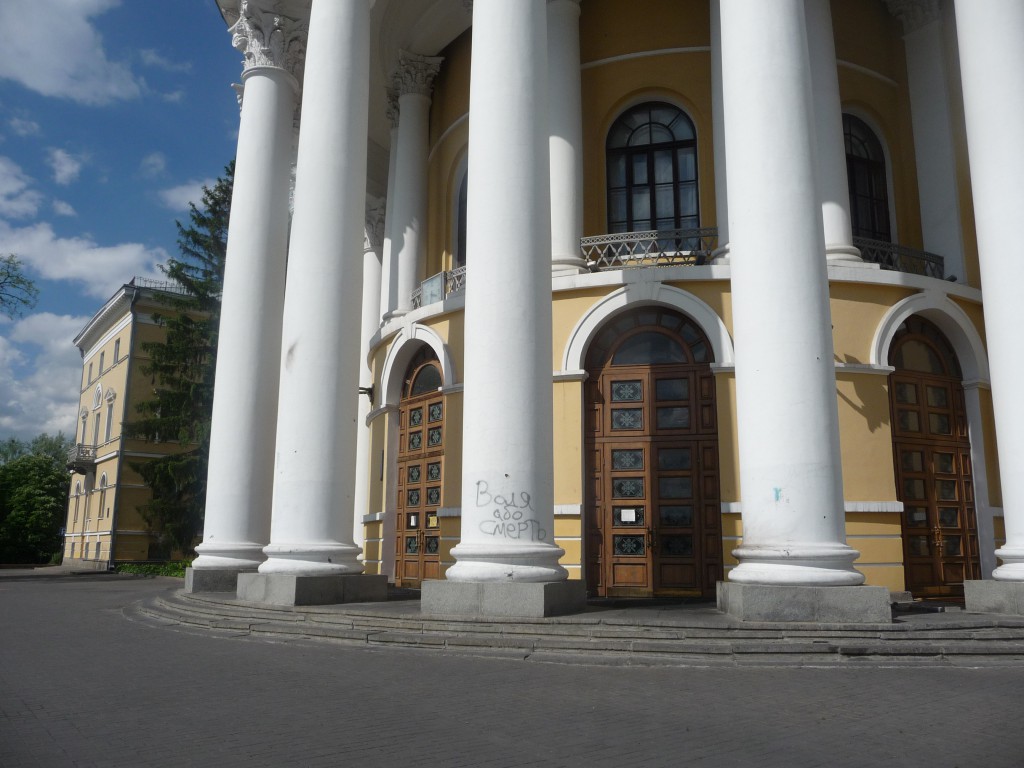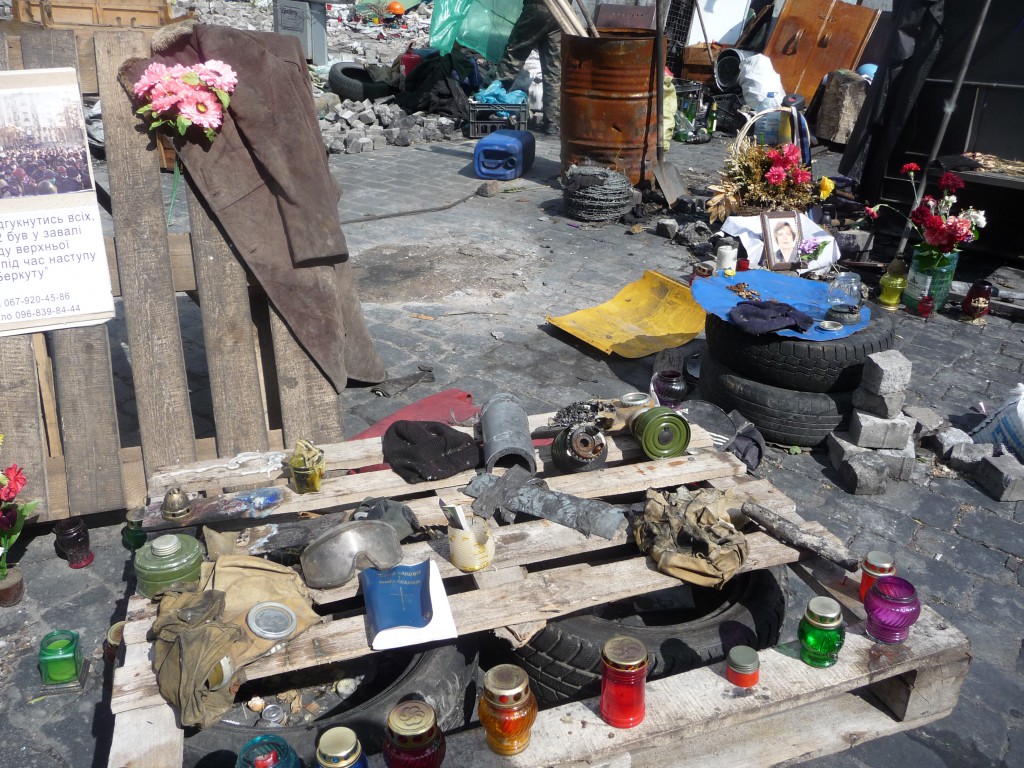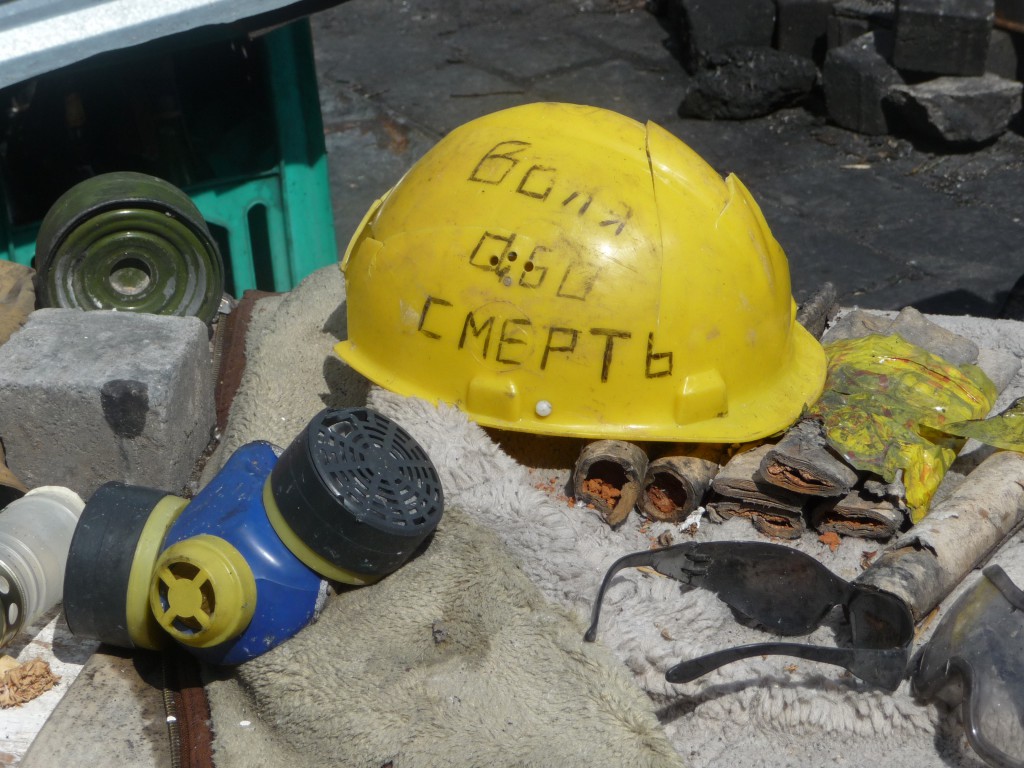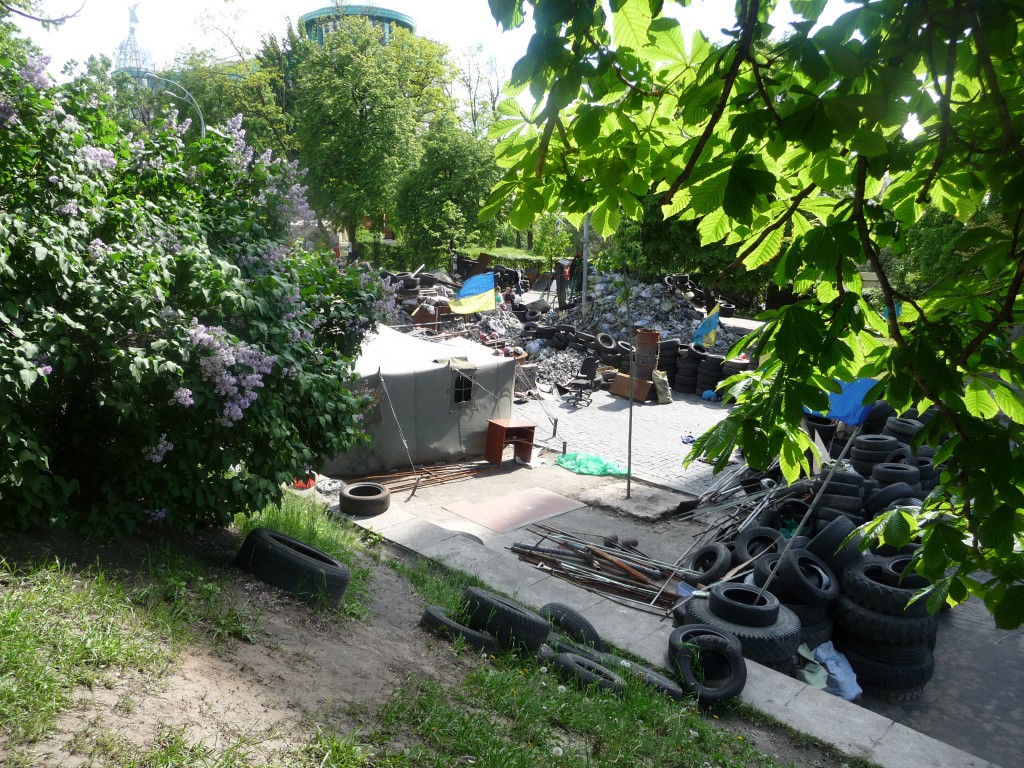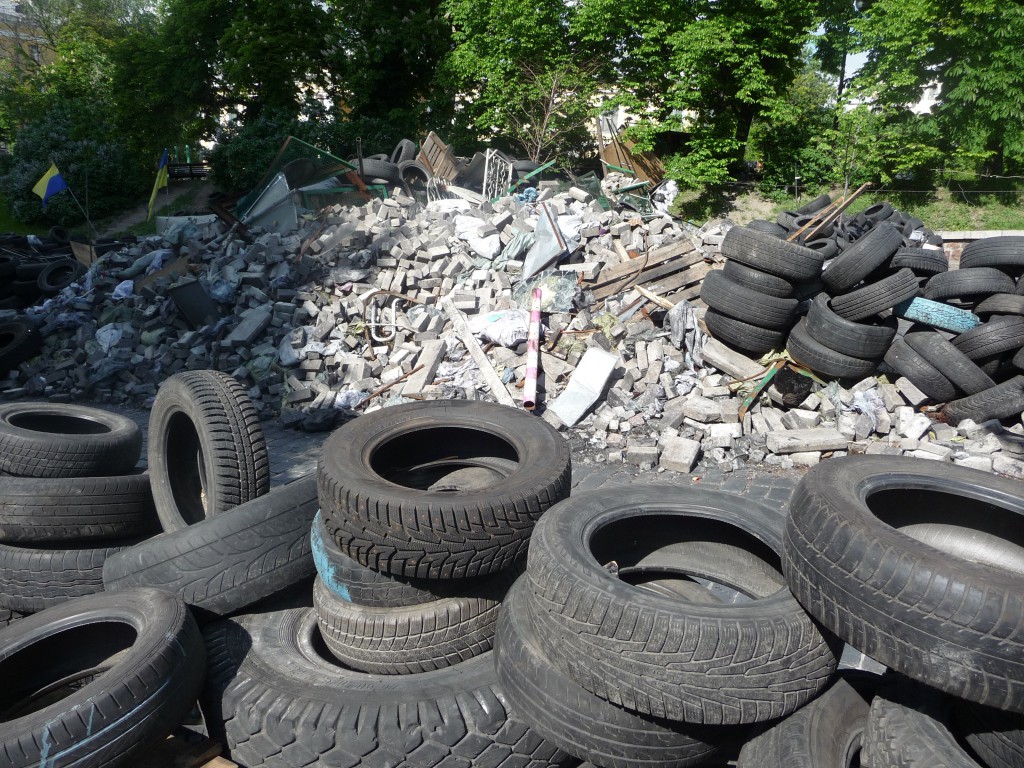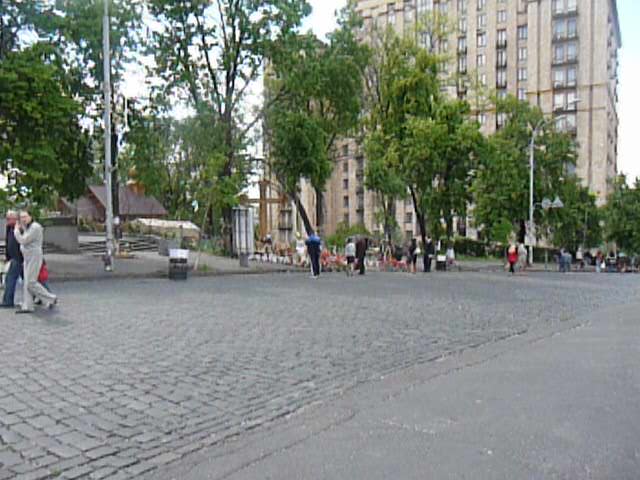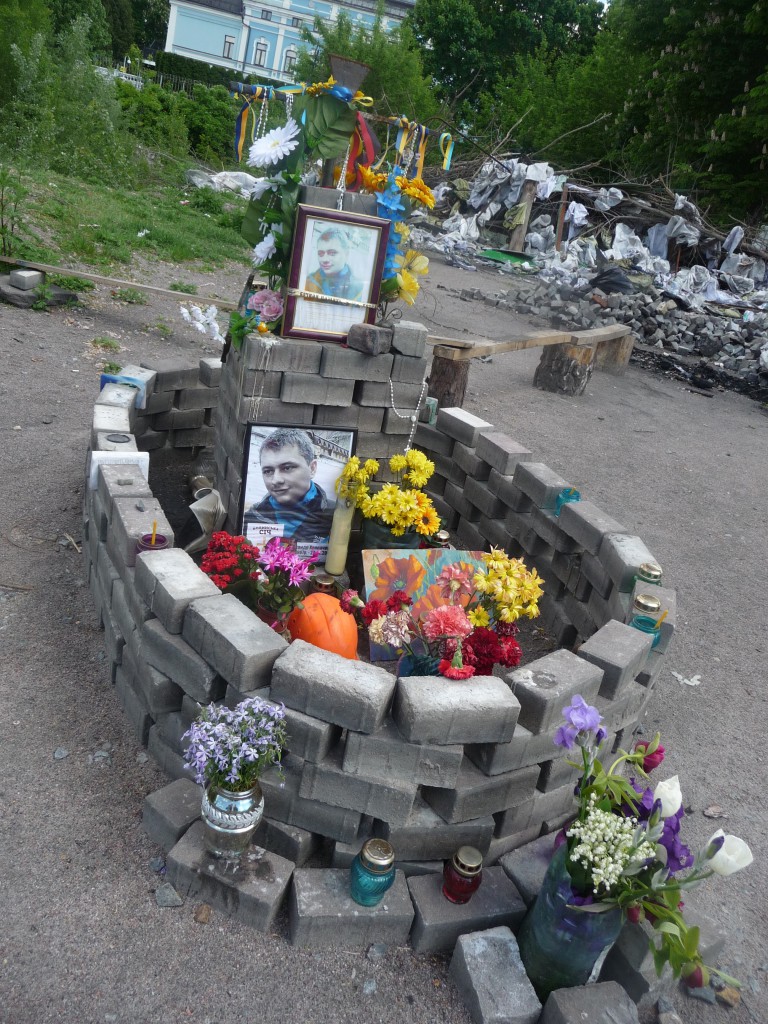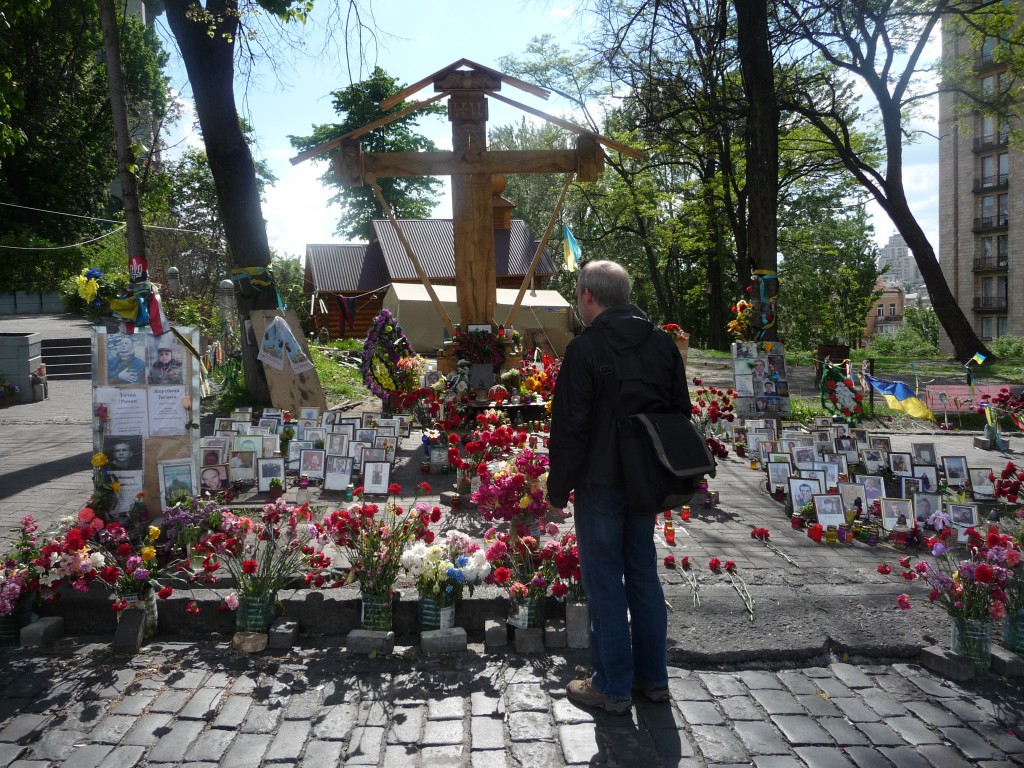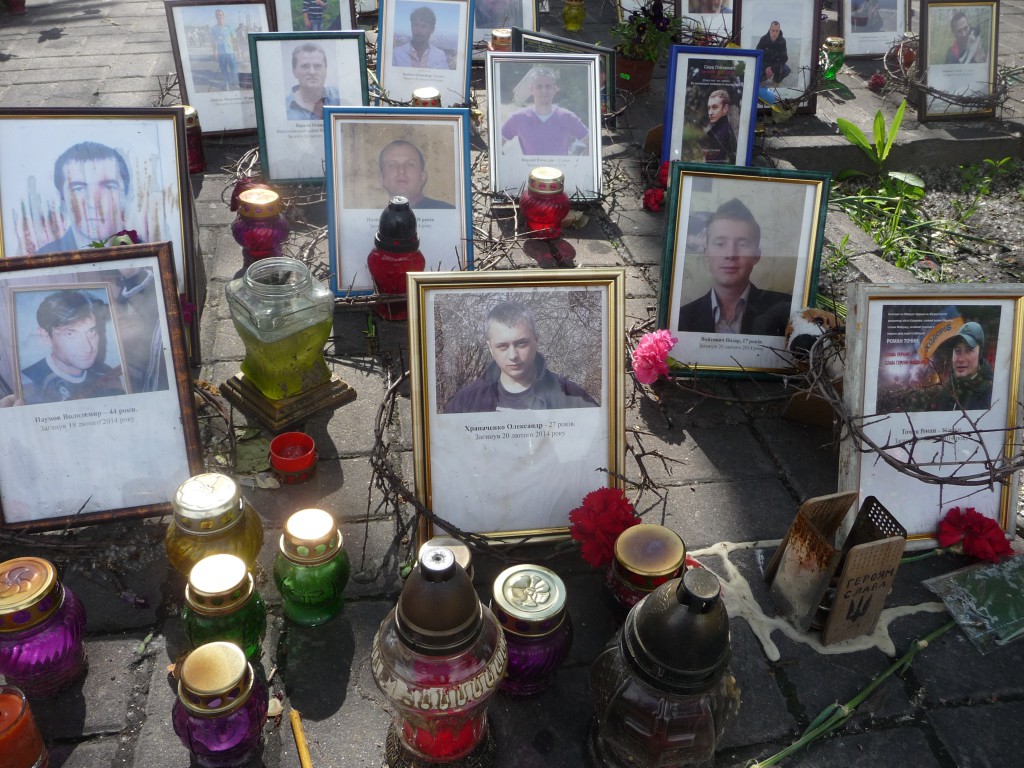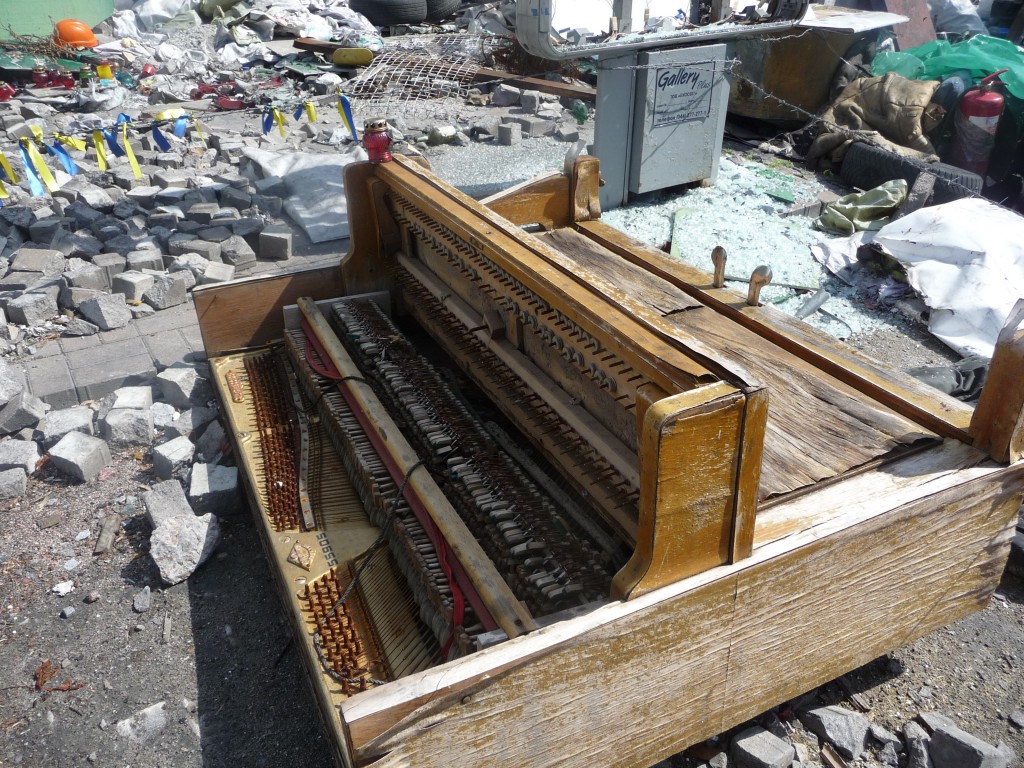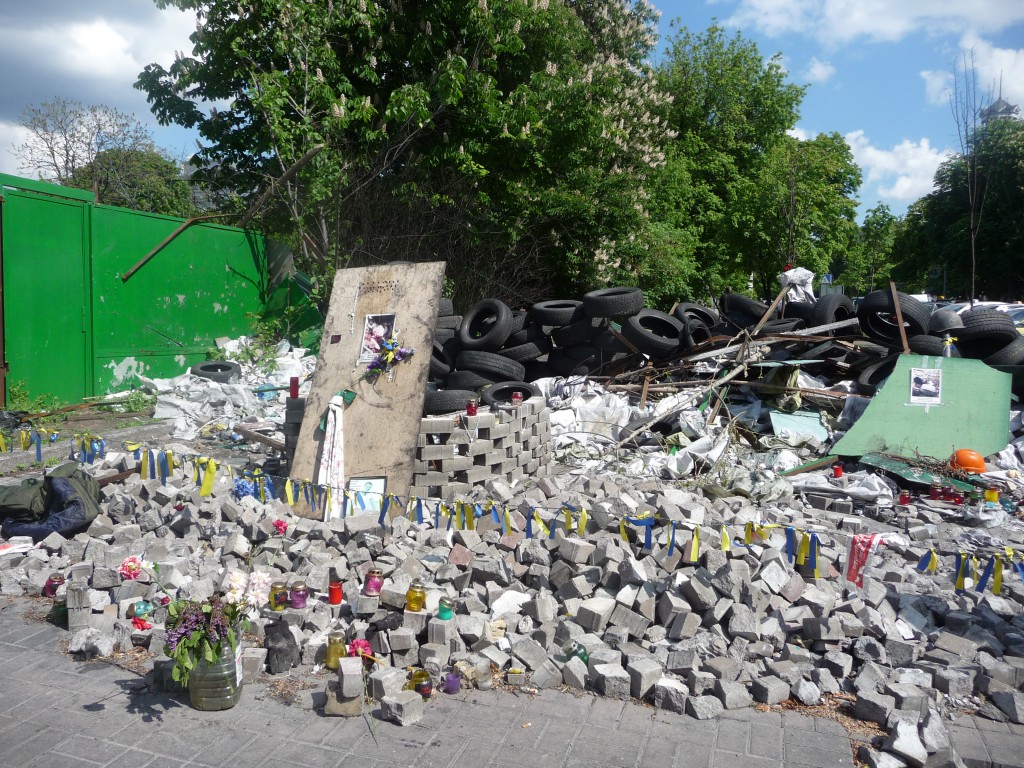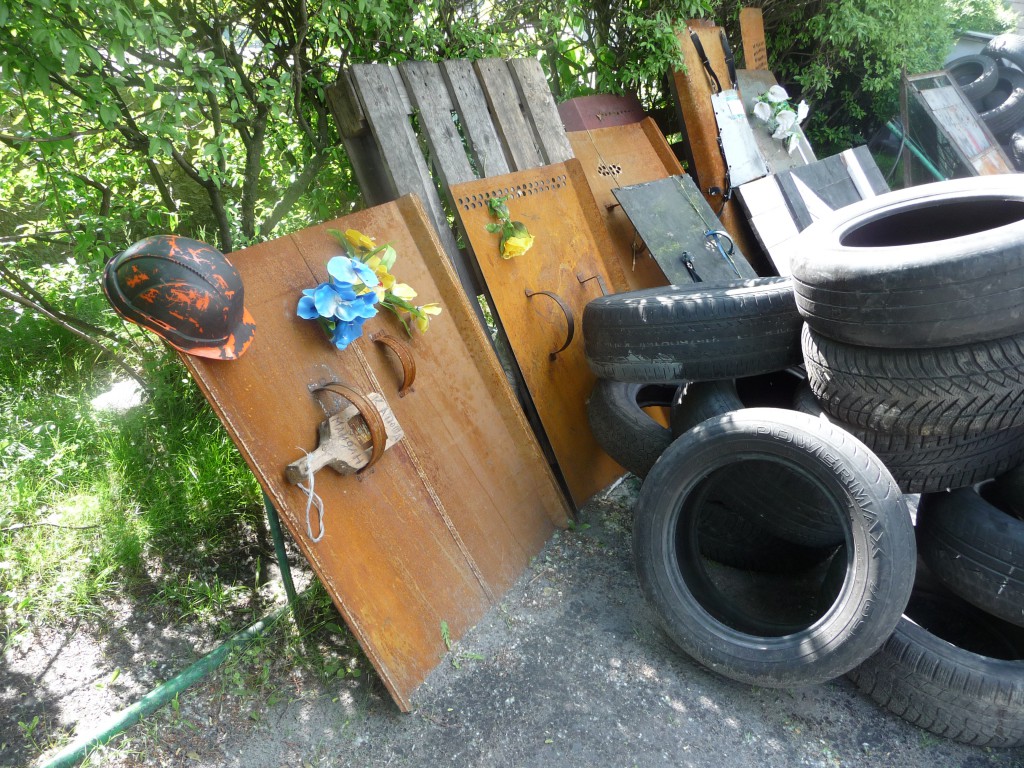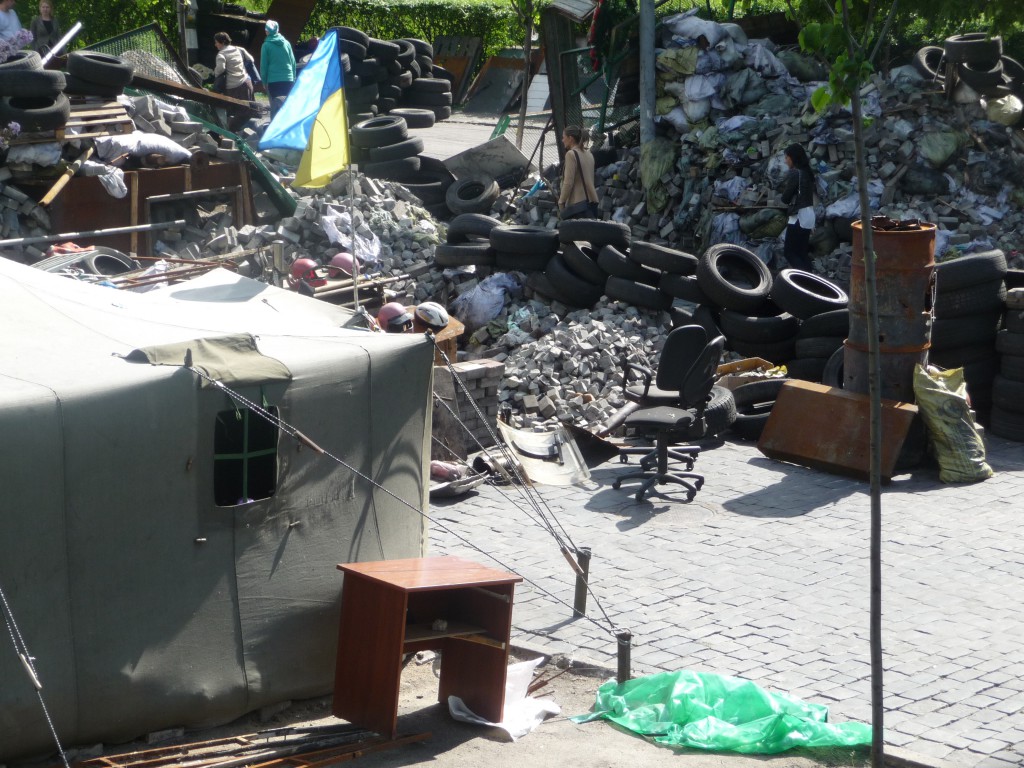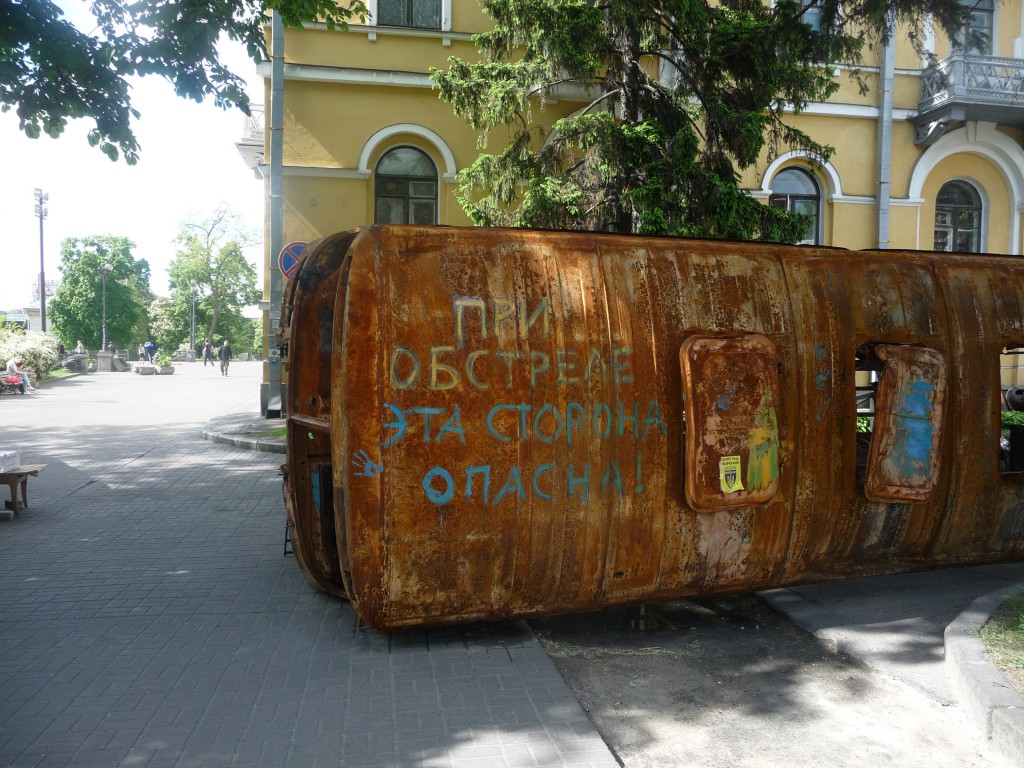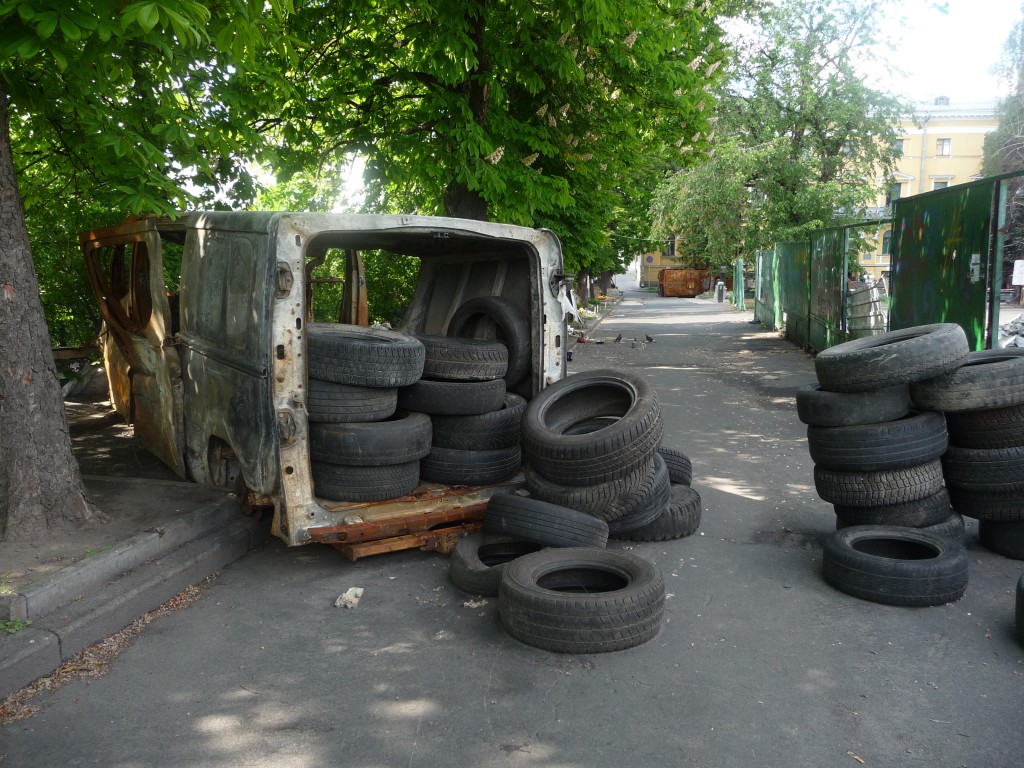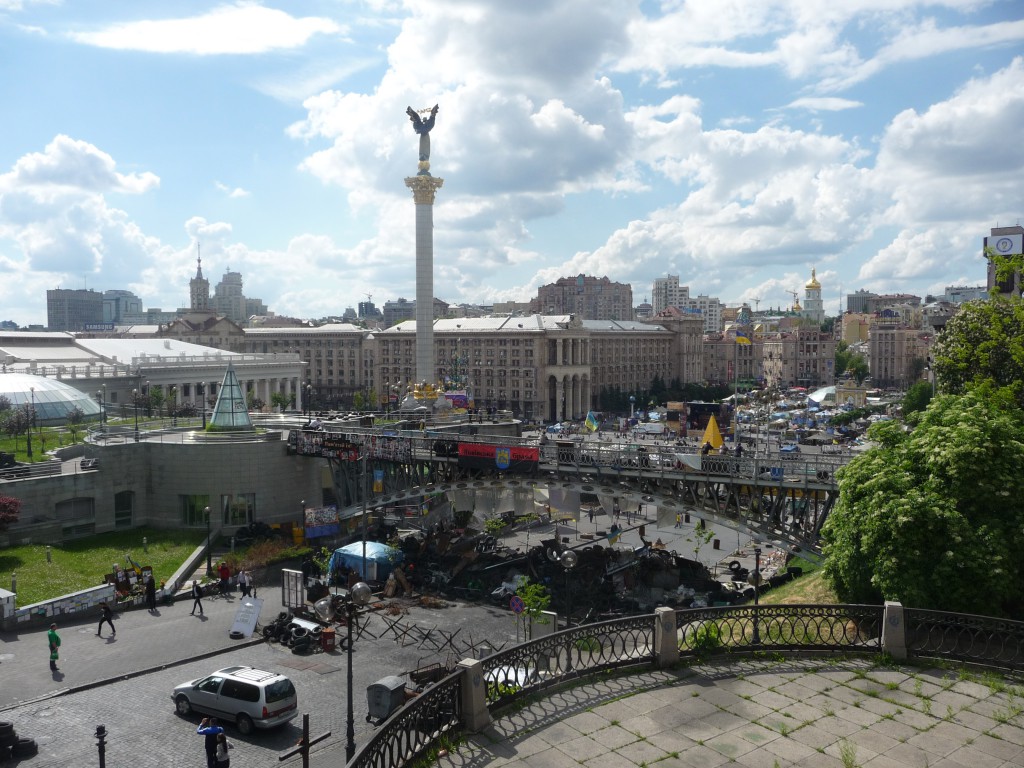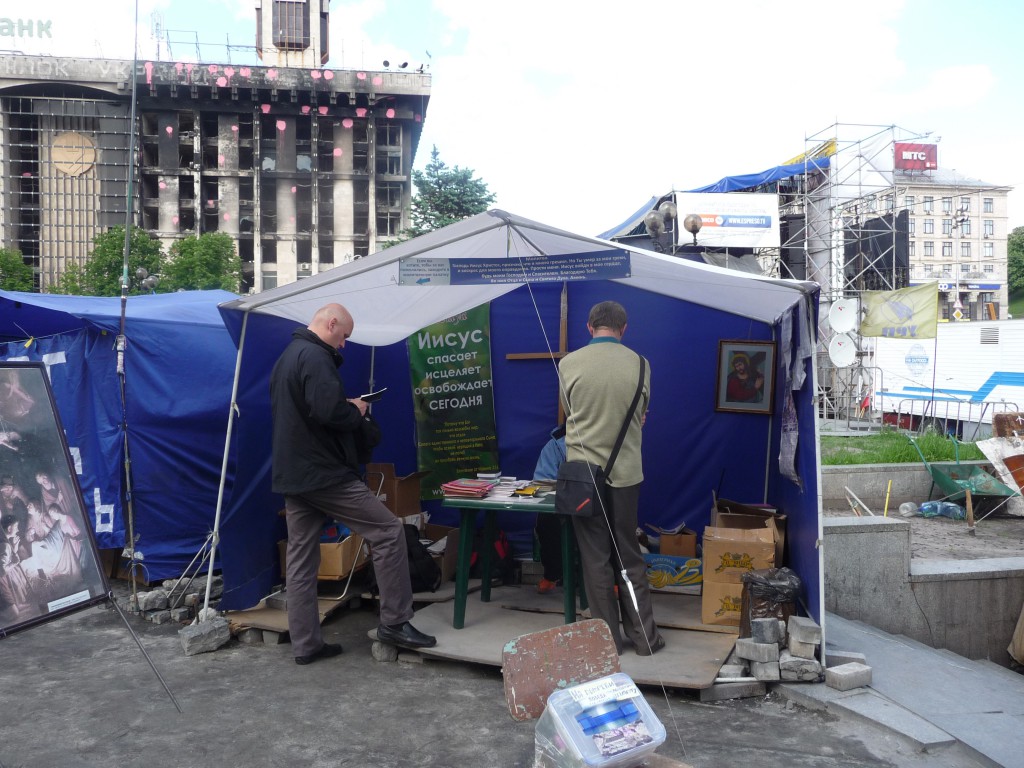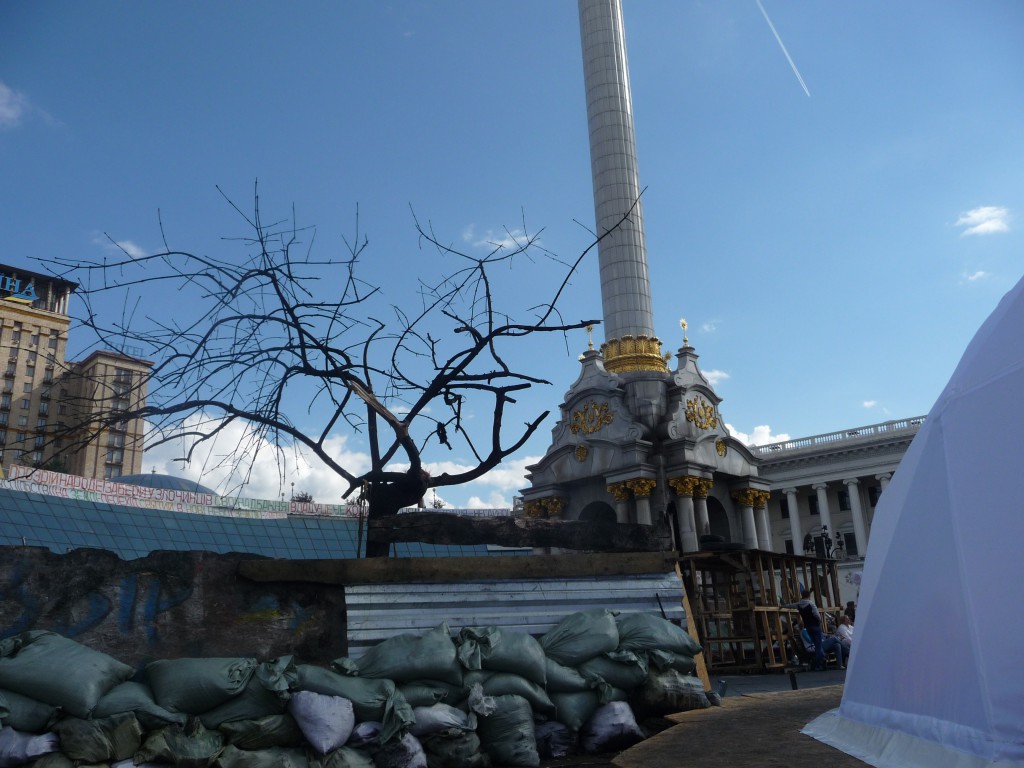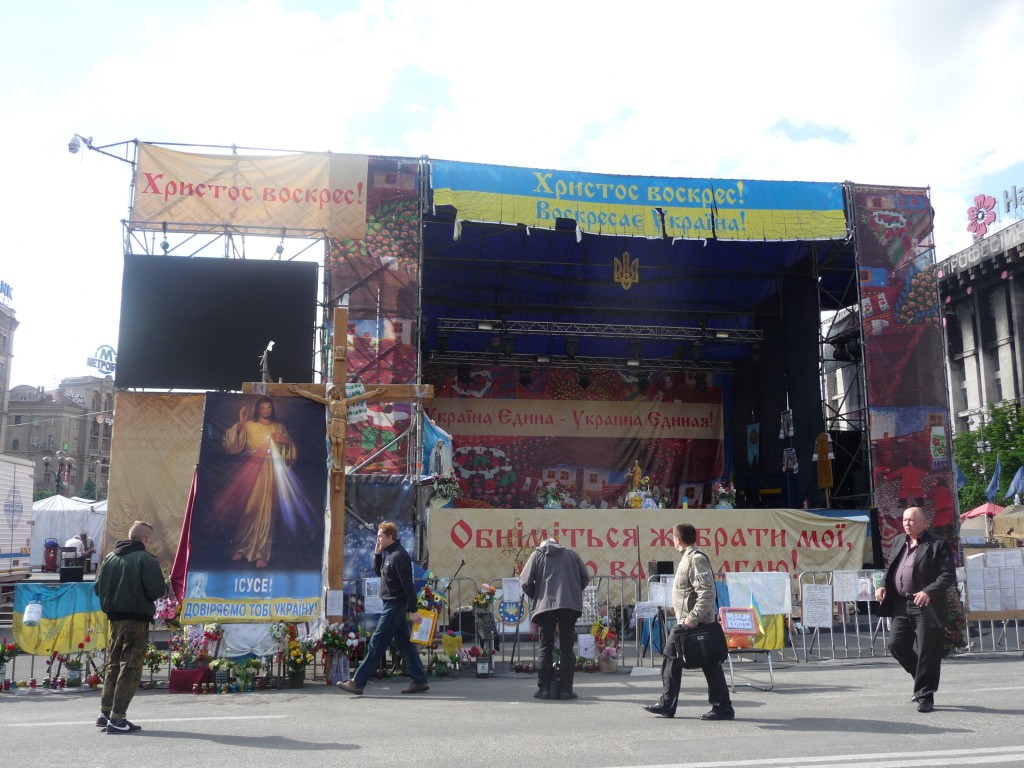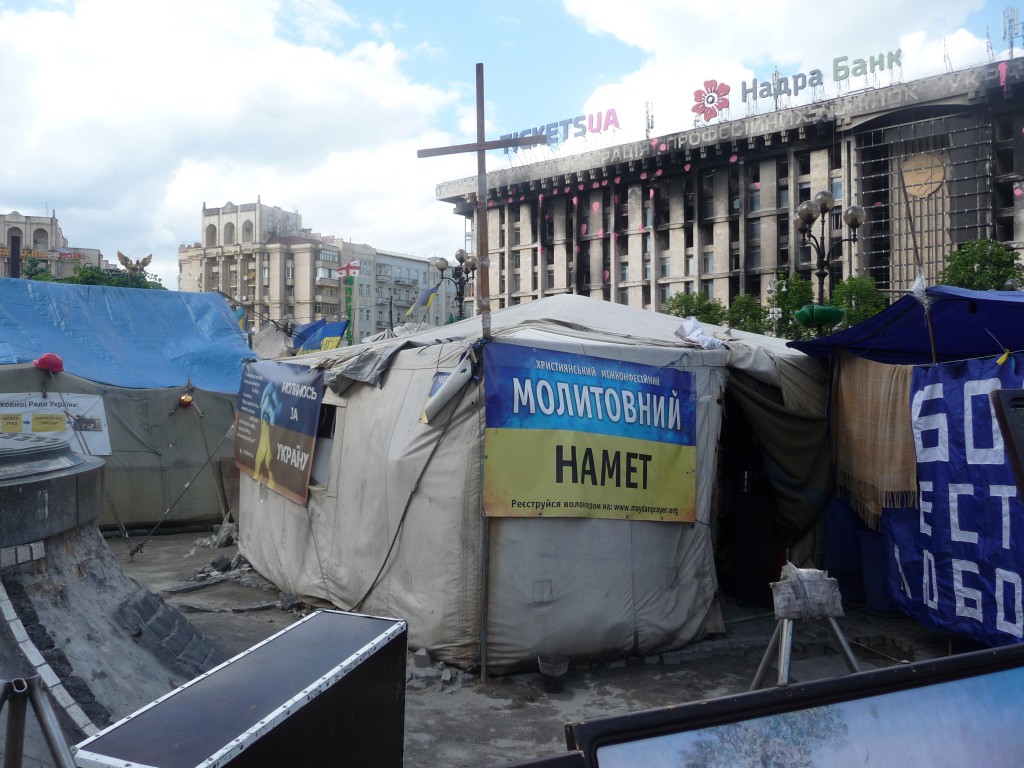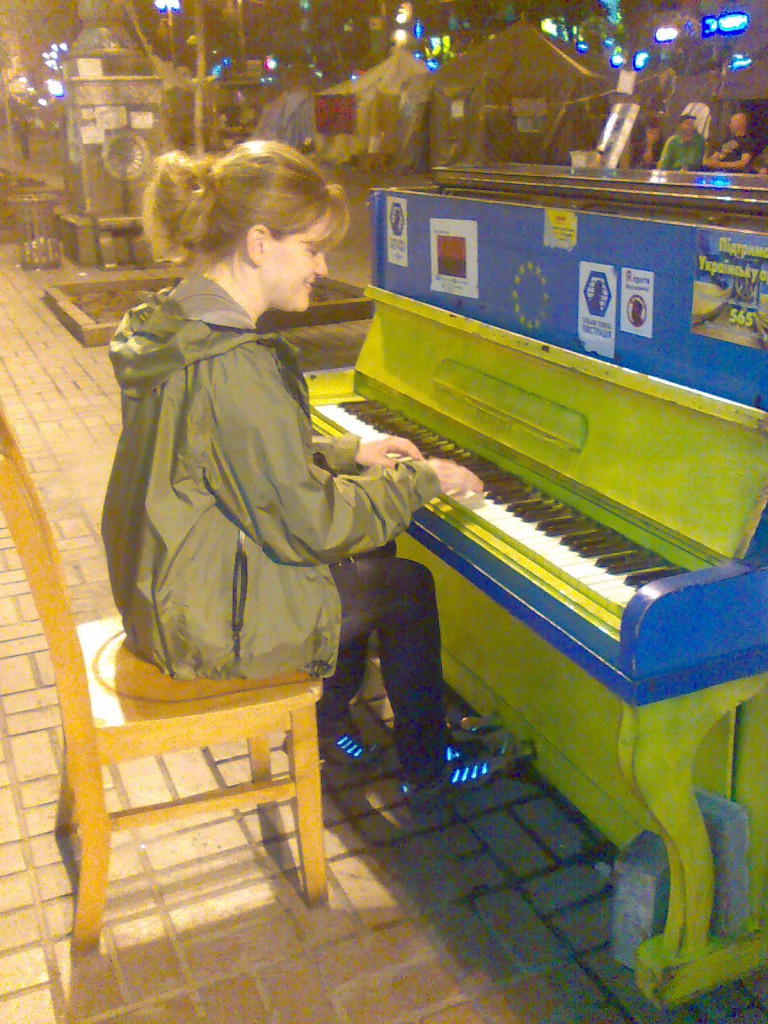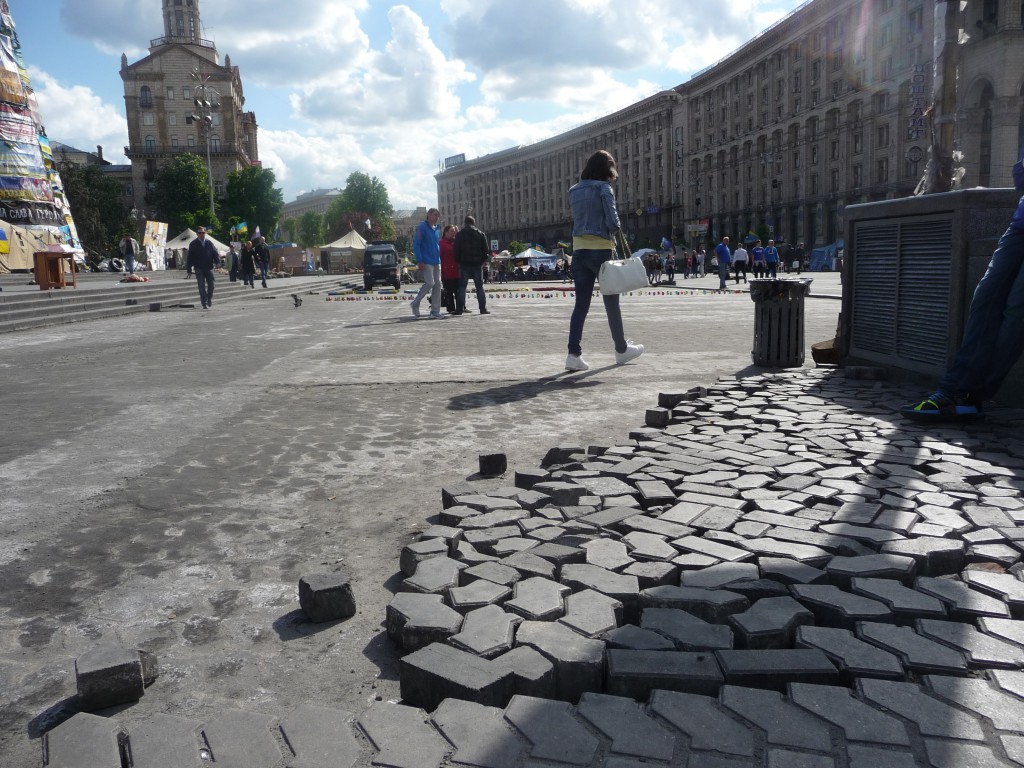Where does one begin trying to tell the story of so many lives, of such profound and far-reaching impact? Simply because I must choose a place and a time, I’ll begin it with an escalator ride up from the subterranean Metro station in the center of Kyiv, Ukraine, on May 13, 2014. It is the fastest escalator I’ve ever ridden, and perhaps the longest end-to-end. It rockets us up from the depths as if we are riding a volcanic eruption, up from the comfortable and anonymous darkness that is the same in any large city of the world, up into the brilliant sunlight streaming through the plate-glass windows at street level. The escalator spews us into sight and sound, into uncompromising clarity.
Beyond the Metro’s doors is the approach to Maidan, a word I had not heard until the previous winter. The Oxford Dictionary says that maidan is a noun meaning, in South Asia, “an open space in or near a town, used as a parade ground or for events such as public meetings.” It comes from Urdu, Persian, and Arabic words of similar spelling and pronunciation.
This is actually my second visit to the Maidan; my wife brought me here last June, when it was the stately center of Kyiv, a place she loves in a city dear to her heart. Today I am a visitor, like one who ventures into a battlefield in some far place and seeks to comprehend a tale to which he has no right. But for Julie, this is a homecoming of vying emotions, a spiritual reunion, and it is not easy.
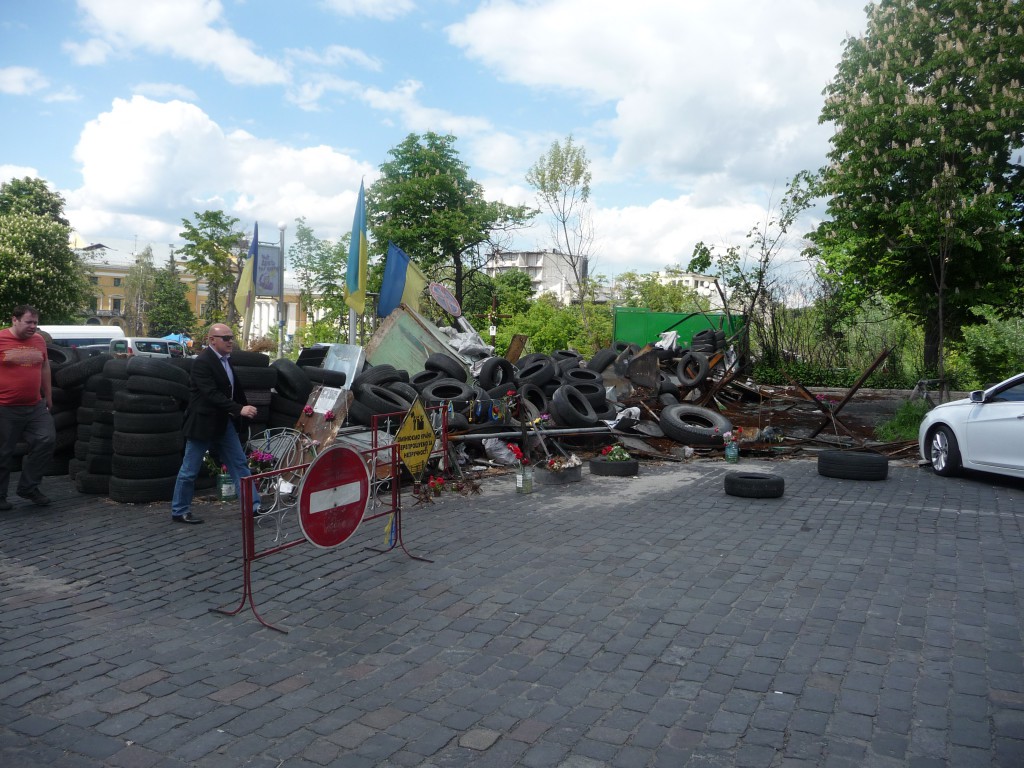
A May morning, three months after the protests in Kyiv; Institutska Street. This was my first sight when we emerged from the Metro station.
The interspersed italicized sections in this post will be Julie’s reflections.
I keep finding myself referring to this visit as a funeral — you know that tight feeling in your throat and gut, that dread mixed with longing you feel when you just must go see that body lying strangely still, when you hate to while wanting to see the faces of others who feel what you feel? As we fly up out of the pit on the escalator, that’s exactly how I feel. I know it will not be the same Kyiv I remember.
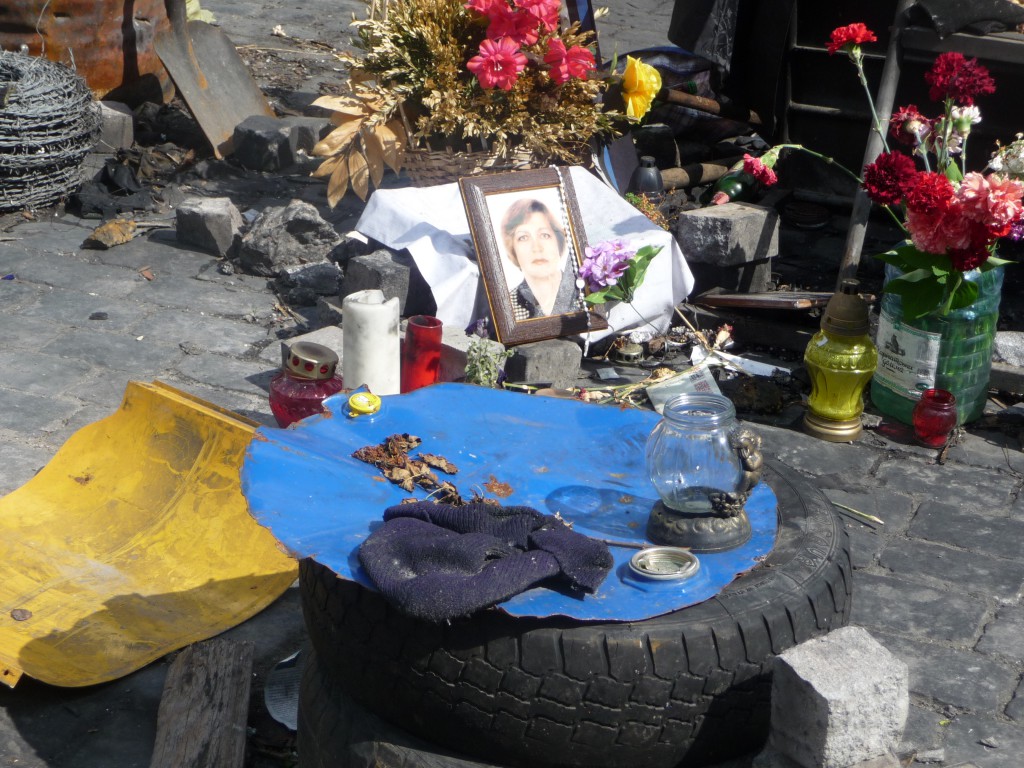
A street of memorials: barbed wire, tires, broken concrete, winter clothing, flowers, candles in colorful glass jars; here is a photo of the woman who was killed, one of the heroes.
Last winter, the world saw the Maidan as a place of fires burning in the night, of thick black smoke. The media buzzed with questions and answers, generally too few, often poorly informed. While the Winter Olympics filled our TV screen, Julie sat with her computer on her lap, poring through articles, reports, and opinion pieces, sending and receiving e-mail, doing all she could to keep up with the situation hour by hour. It was a terrible frustration to her that she could not be in Ukraine to lend support, to stand with the people she loves.
I understood then something of what was taking place. But it is today, when Kyiv thrusts me up into the light, that I begin to understand the Maidan as I wish more of us could.
We step out of the Metro at the top of Institutska Street, an avenue that climbs steeply up from the Maidan toward the Parliament building. This is the street on which some of the Heavenly Hundred were shot down by snipers as they marched, either unarmed or armed mainly with wooden sticks, protected by makeshift shields of wood or sheet metal.
We notice at once that the Maidan is a memorial, but it is not only a place of the dead. The debris, the thousands of car tires have been carefully stacked and scooped into monuments and markers that do not block the flow of traffic.
But they are on hand, ready to be reformed into barricades if needed. Guardians of the Maidan are here in their combat fatigues — camping, maintaining, waiting.
Ukraine is famous for its buckeye trees, and they are in full bloom, casting deep, tranquil shade. Perhaps it is the buckeye flowers that are dropping white seed fluff that falls around us like snow.
Kyiv bustles on. Cars creep up and down Institutska Street. Sometimes soldiers move aside wooden barricades to let them through. Pedestrian traffic flows along the sidewalk: citizens of Kyiv going to and from work — shopkeepers, businesspeople, the elderly, priests . . . there are a few journalists with long-lensed cameras, sitting in cars with open doors, scribbling in notebooks. But at least half the people here seem to be pilgrims — some local, some from other parts of Ukraine, some international — families, couples, the solitary, the grieving . . . standing before the ubiquitous handmade monuments, reading the hand-lettered signs, searching the hundreds of faces in photographs — pictures fixed to trees, to fences, set on easels, covered with plastic against days of bad weather, ringed by flowers and candles in little jars of colored glass.
It has become a neighborhood of memorials lining streets for blocks in every direction: names, places, dates of birth, dates of death that are all during a few days in February 2014. Their faces gaze at us from the portraits — most solemn, some smiling, men of vision, men of talent. And one woman. Julie finds a young man from Rivne, a friend of a friend. Many signs extol the heroi, the heroes.
Still at the top of Institutska Street, I feel a wave of emotion at the sight of the many objects that were clearly a part of last February’s events: plastic hardhats, just like the kind I wore in my labor job, many of these cracked . . . a rusted barrel full of wooden poles like the handles of spears, weapons intended to defend citizens against armed forces. Gas masks, piled among the bricks and tires. Overcoats that sheltered people against the winter. This is not a battlefield of long ago; it is so recent that rains have not yet washed away the ash.
In addition to the nearly one hundred killed by snipers, there are several hundred wounded or missing. And there are thousands who stood in the cold, who were hosed down by police in the subzero temperatures, who suffered from tear gas, were bruised by rubber bullets, and beaten over the head with batons . . .
Most of all, I am drawn to the shields. They are three or four feet high, two feet across — heavy, rusty pieces of sheet metal with handles welded on. These stand in rows all along the street, leaning against fences, trees, barricades — not replicas, but real shields held in warriors’ hands three months ago. I cannot help seeing a parallel to war in the ancient world. Just to pick up and carry such a shield would take strength and fierce determination.
I think of Thermopylae, for these look very much like the Spartan shields as represented in the movie 300. I think of the connections between that fight and this one: a few hundred making a stand in a narrow place against a vast number of invaders, with a courage that most of the world would call madness. Thermopylae was the Hot Gates, the Gates of Fire, a strip of land between the mountains and the sea, where the Earth sent up heat and fumes.
At the Maidan, too, was fire and smoke. Here was a sacrifice that made the world take notice. Here, the Heavenly Hundred achieved with their deaths a victory like that of Leonidas and his three hundred Spartans, who held off the numberless Persian horde long enough for Greece to rally and to discourage the great eastern King from attempting to claim a land that would not yield. The Maidan, too, held through those days and nights of burning. The Maidan held, and a nation rose to its feet.
As we walk down Institutskaya, it is all hallowed hush, punctuated by a few clacking, business-like heels. Life must go on, after all, and Kyiv isn’t sleeping. Businessmen and women, and local residents who are just trying to get on with their lives walk by while others stop, stare, bend down, read and try to process this thing that has happened in their beautiful city. In my beautiful city where I met with friends until past midnight, sipping coffee in one of the many cafes. Where we strolled one snowy March 1, past the very same buildings on a magical evening.
We work our way down the quiet street to the Maidan itself, which is a hub of activity. Music blares over loudspeakers, some festive and light, some patriotic and solemn. The deep, haunting melody played at the funerals of the Heavenly Hundred comes on, giving the Maidan its truest soundtrack.
It still smells like soot. And death. And life and honor.
Fire was definitely here. The tall Trade Unions building stands gutted and blackened, where the injured lying in the field hospital there perished in flame. [Reportedly, it was set on fire by police, as it had been the protestors’ headquarters]. Skeletons of a few trees spread stark, charred branches that will not bud again.
The buildings look smudged and weary. The stage is here, on which concerts were held and prayers were chanted during the protest. I think about the courage it must have taken to stand on that stage, for a thousand windows might grant sniper access.
There are tent cities in the heart of Maidan, stations from various parts of Ukraine, here to maintain a presence, to lend support. Old men at a table play a game we cannot quite see. One soldier stirs a bubbling soup pot; another rests before the door flap of his tent. A pair of military pants dries on a clothesline. Near the stage, a small girl runs in happy circles to startle a flock of foraging pigeons.
The mood is a mix of funeral and carnival — funeral at the top of the hill with a certain bit of carnival down in the square, where vendors sell all kinds of Maidan “swag.” There is even a large carousel spinning incongruously down on Khreschatyk — right across from the tents.
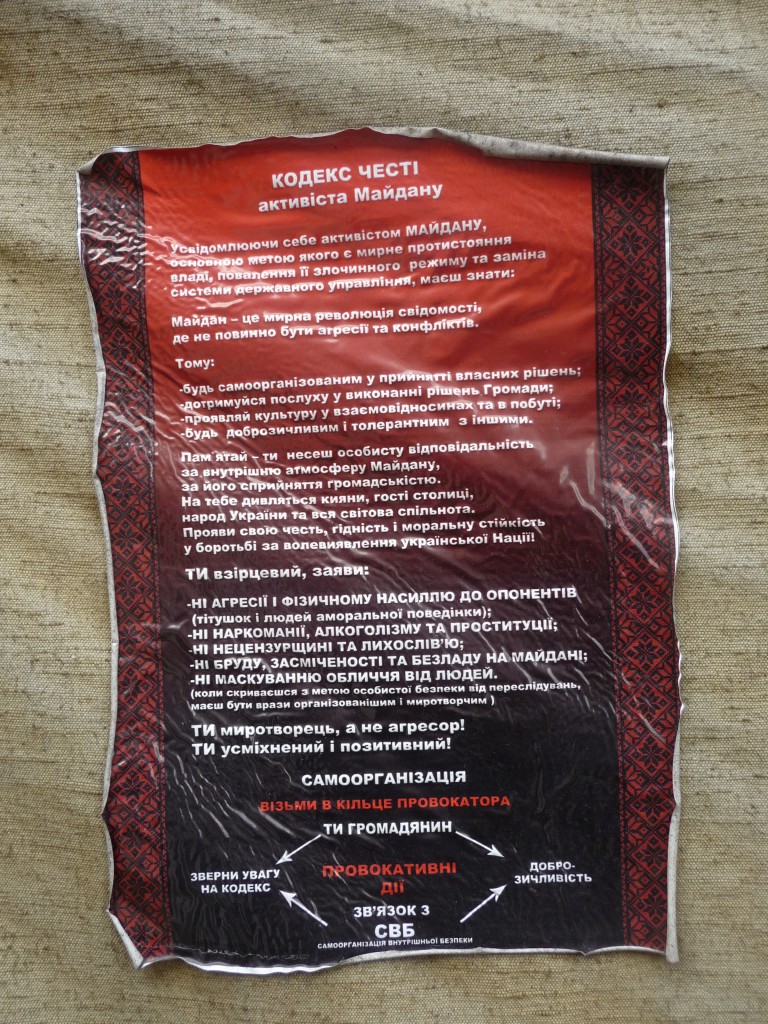
Detailed rules of conduct were observed in the Maidan from the time of the protests onward: there is no drinking, no use of drugs, no prostitution, avoidance of bad language. Behavior shall be orderly and organized. Masks shall not be worn except for personal protection. Those here shall be peacemakers, not aggressors.
A few nights later we are back at the Maidan, strolling and talking with an old friend of Julie’s. We come upon the blue-and-yellow piano, painted with the colors of the Ukrainian flag, a piano made famous by so many videos of a man who became known as the “piano-playing extremist” as he lifted the spirits of protestors through many wintry nights. Remarkably, it is still in tune – surely someone must come often to tune it! It is perched on the street directly in front of City Hall. Our friend and I look expectantly at Julie. “Aren’t you going to play it?” we ask. It is here to be played in honor of the heroes, for the love of Ukraine. Julie sits and plays a beautiful melody that she is making up on the spot, or perhaps she is receiving dictation from this honored pavement itself, from the near-full moon, from the grand and imposing Soviet buildings that watch over Khreschatyk.
- Even though the hour is late, the soldiers before their tents glance up with approval, and a small crowd gathers to listen. I take Julie’s picture, knowing that this will be one of my longest-lasting memories of this place. It is fitting that the girl who worried and prayed so much for Ukraine during the dark time is here at last, playing for this land and people she loves. She has brought her gift of music, and tonight, Maidan gets to hear it. The melody drifts across the charred stones, floats over the tents, alive with the stirring of willows and buckeyes, with the voice of the Dnipro River. Ukraine is a country of music, of poetry, a place where the spirit can rise. These moments at the colorful piano are the right ending for our visit to Maidan.
I felt a Funeral, in my Brain
I felt a Funeral, in my Brain,
And Mourners to and fro
Kept treading – treading – till it seemed
That Sense was breaking through –
And when they all were seated,
A Service, like a Drum –
Kept beating – beating – till I thought
My mind was going numb –
And then I heard them lift a Box
And creak across my Soul
With those same Boots of Lead, again,
Then Space – began to toll,
As all the Heavens were a Bell,
And Being, but an Ear,
And I, and Silence, some strange Race,
Wrecked, solitary, here –
And then a Plank in Reason, broke,
And I dropped down, and down –
And hit a World, at every plunge,
And Finished knowing – then –
